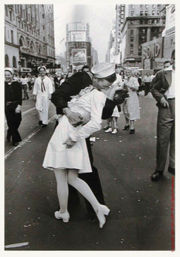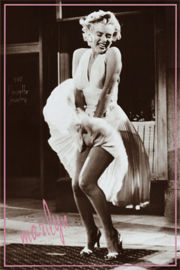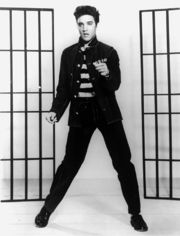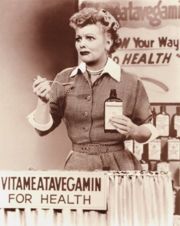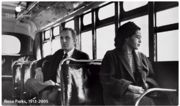Another Shot
From fifties
Our project is the exploration of the 1950's through photography. Many iconic photographs were taken in the 1950's -- photographs that have become iconic in many different ways. They are significant to life both historically and socially, capturing the celebrities we find so fascinating, as well as documenting moments in our history. Regardless of how these images became iconic, they all say much about the fifties and much about today. Our project sought to recreate these iconic images around The Evergreen State College, as well as researching each original image. Recreating these photographs was both fun and hard, and we hope they are enjoyed.
Contents |
[edit] Kiss on VJ Day
Taken in August 14 1945 in Time Square, this celebration of the end of WWII is one of the most famous images. Although the nurse and sailor are still unknown the search continues. In a New York Times article from August 2007 the sail is thought to be Glenn McDuffie. Now 80 Glenn claims to be the sailor in the photo. He is not the only one, 11 other men have claimed to be the sailor and only three women have stepped forward to claim to be the nurse. The nurse is thought to be Edith Shane. The end of WWII shaped much of what the 1950s would become. The many returning GI, came back to the states and began families, sparking a boom in children, a high demand for affordable housing and a whole new generation of successful families.
[edit] Marilyn Monroe
Discover while working at a Radio Plane Munitions factory during WWII Marylin Monroe soon became America's dream girl. Her birth name is Norma Jeane Baker. In 1946 after divorcing her first husband and excepting a contract with Twentieth Century Fox she dyed her hair blond and changed her name to Marylin Monroe. In 1954 Marylin married Joe DiMaggio. The superstar couple didn't last long, Marylin's sexual identity in the world was not cohesive with Joe. This photo is an image from Marylin's movie "The Seven Year Itch". Released in 1955 Marylin plays the seductive next door neighbor to a husband who is left alone for the summer, while his wife and family go on vacation.
[edit] Douglas Macarthur
No soldier in modern history has been more admired -- or more reviled. Douglas MacArthur, liberator of the Philippines, shogun of occupied Japan, mastermind of the Inchon invasion, was an admired national hero when he was suddenly relieved of his command. His brilliant military career at an end, MacArthur returned to the United States for the first time in 15 years. He received a hero's welcome at a number of cities throughout the country as he made his way to Washington. On April 19, 1951, MacArthur was invited by conservatives to address a joint session of Congress. In a memorable speech he defended his plan for escalating the war that had led to his dismissal, concluding with a line from an old Army ballad that has since come to be associated with him: “Old soldiers never die; they just fade away.”
[edit] Elvis Presley
Simply put, Elvis Presley was the first real rock & roll star. A white Southerner singing blues laced with country, and country tinged with gospel, Elvis Presley brought together American music from both sides of the color line and performed it with a natural hip-swiveling sexuality that made him a teen idol and a role model for generations of cool rebels. He was repeatedly dismissed as vulgar, incompetent, and a bad influence, but the force of his music and his image was no mere merchandising feat. Presley signaled to mainstream culture that it was time to let go. Today, over 30 years after his death, Elvis Presley’s image and influence remain undiminished. While certainly other artists preceded him and he by no means “invented” rock & roll, he is indisputably its king.
[edit] Dwight D Eisenhower, Richard Nixon
This photo was taken in July of 1952 at the Blackstone Hotel in Chicago, as Dwight D. Eisenhower and Sen. Richard Nixon of California share a laugh during their campaign for presidency. Eisenhower and Nixon won the election for the Republican party. This duo occupied the white house for most of the 1950's. Eisenhower was the old president of a young country. Although he was a part of such nuances as the space race "Ike" was often out of touch with the new pulse of the United States. Nixon went on after his vice presidency to have a memorable presidency of his own but his time Ike's side was when he came into his own as a politician. His politics were never about ideology they were politics of self, a pragmatist to the bone he did not work well with everyone. Nixon never stopped, once in politics he continued to strive for higher and higher office until as we all know he reached the political top and hit a moral bottom.
[edit] Lucille Ball
By the end of 1952 there were 19 million television sets in American homes and one of the stars on those TVs was Lucille Ball. Lucy was a brilliant vocal and visual comedian, something that made her irresistible. Sponsored by Phillip Morris the show I Love Lucy aired on October 15 1951. Lucy was delighted about the show and demanded that her husband in real life play her TV husband. Desi Arnaz surprised everyone with his acting skills and the show became a hit. By April 7 1952 10.6 million were watching I Love Lucy. This and many other shows began the TV era. Millions of Americans found a new pastime, in their living rooms in front of a black and white television.
[edit] Rosa Parks
Rosa Parks, the "mother of the civil rights movement" was one of the most important citizens of the 20th century. Mrs. Parks was a seamstress in Montgomery, Alabama when, in December of 1955, she refused to give up her seat on a city bus to a white passenger. The bus driver had her arrested. She was tried and convicted of violating a local ordinance.
Rosa Parks had been tired. Not as much physically tired, as tired of the treatment she and other African Americans received every day of their lives.
Her act sparked a citywide boycott of the bus system by blacks that lasted more than a year. The boycott raised an unknown clergyman named Martin Luther King, Jr., to national prominence and resulted in the U.S. Supreme Court decision outlawing segregation on city buses. Over the next four decades, she helped make her fellow Americans aware of the history of the civil rights struggle. Her example remains an inspiration to freedom-loving people everywhere.
